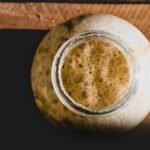Simple Sourdough Starter Recipe
This recipe walks you through the process step by step. No commercial yeast, no complicated ingredients — just flour, water, and time.
Servings 1 starter
Calories 65kcal
Equipment
- A glass jar or clear container (at least 1 quart)
- A spoon or spatula
- A kitchen scale (recommended for accuracy)
- A breathable cover (cloth, paper towel, or loose lid)
Ingredients
- 120 g 1 cup whole wheat flour or rye flour (for best results starting out)
- 120 g ½ cup water, filtered or dechlorinated
- Additional unbleached all-purpose flour and water for feedings
Instructions
Day 1
- Mix 120 g flour and 120 g water in your jar.
- Stir well until no dry bits remain.
- Cover loosely and leave at room temperature (70–75°F / 21–24°C).
Day 2
- You may or may not see bubbles yet. Don’t worry!
- Discard about half the starter. Add 60 g flour + 60 g water. Stir and cover again.
Days 3–5
- Feed every 24 hours: discard half, add fresh flour and water in equal weights.
- By Day 3 or 4, you should start seeing bubbles, a tangy smell, and some rise.
Days 5–7
- Continue daily feedings. Your starter should be doubling in size within 4–8 hours after feeding.
- Once it does this consistently for 2–3 days in a row, it’s ready to bake with.
Notes
Tips for Success
Flour choice matters: Whole wheat or rye helps kickstart fermentation. Once active, you can switch to all-purpose flour.
Water quality counts: Chlorine can slow fermentation — if possible, use filtered or let tap water sit out overnight.
Temperature is key: Starters thrive at 70–75°F (21–24°C). Cooler kitchens may take longer.
Consistency check: A healthy starter smells pleasantly tangy, not rotten.
